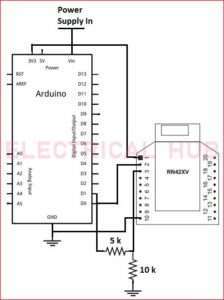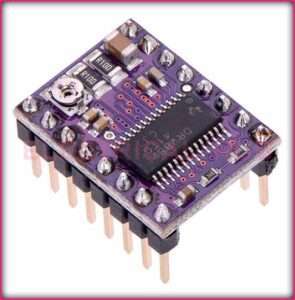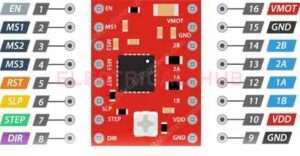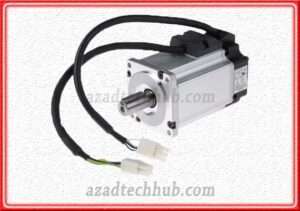Ultrasonic Sensor Motor with Arduino: Best Overview
The combination of an ultrasonic Sensor Motor with Arduino microcontroller opens up a world of possibilities for various DIY projects and automation applications. In this guide, we will explore the concept of an ultrasonic sensor motor with Arduino setup, its components, how it works, and potential applications.

Read More About
Components of an Ultrasonic Sensor Motor with Arduino Setup
Ultrasonic Sensor: An ultrasonic sensor is a device that emits high-frequency sound waves (ultrasonic waves) and measures the time it takes for the waves to bounce off an object and return. This data is used to calculate the distance between the sensor and the object.
Motor: Motors can vary in type, including DC motors, stepper motors, or servo motors, depending on the specific project requirements. Motors convert electrical energy into mechanical motion and are a fundamental part of any motorized system.
Arduino Microcontroller: The Arduino microcontroller is the brains of the operation. It receives data from the ultrasonic sensor, processes it, and controls the motor based on the programmed logic.
Motor Driver: In many setups, a motor driver is used to interface the Arduino with the motor. It provides the necessary power and control signals to drive the motor efficiently.
How the Ultrasonic Sensor Motor with Arduino Setup Works
The operation of an ultrasonic sensor motor with Arduino setup involves several key steps:
Ultrasonic Sensor Data Acquisition: The ultrasonic sensor emits ultrasonic waves, which bounce off an object and return to the sensor. By measuring the time it takes for the waves to return, the Arduino can calculate the distance to the object.
Data Processing: The Arduino processes the distance data obtained from the ultrasonic sensor. It can use this information to make decisions based on the proximity of objects.
Control Logic: Depending on the programmed logic, the Arduino determines how the motor should respond to the distance data. For example, it can instruct the motor to move forward, backward, stop, or change direction based on the detected object’s proximity.
Motor Control: The Arduino sends control signals to the motor (through a motor driver, if necessary) to initiate the desired motion. For example, if an object is too close, it can command the motor to stop or reverse.
Feedback Loop: The ultrasonic sensor continues to provide real-time data, allowing the Arduino to continuously monitor the environment and adjust the motor’s behavior accordingly. This creates a feedback loop that ensures the motor responds dynamically to changing conditions.
Applications of Ultrasonic Sensor Motor with Arduino Projects
The versatility of ultrasonic sensor motor with Arduino setups opens up numerous applications, including:
Obstacle Avoidance Robot: Build a robot that can navigate autonomously while avoiding obstacles in its path using ultrasonic sensors to detect objects.
Automated Door Opener: Create a door-opening system that opens and closes automatically when someone approaches or departs, enhancing accessibility and convenience.
Distance Measurement Tools: Use the ultrasonic sensor to measure distances accurately, which can be applied in fields like surveying, home improvement, or even as a parking assist system.
Smart Home Automation: Implement a range of smart home projects, such as controlling curtains or blinds, adjusting lighting based on occupancy, or even developing a voice-controlled home assistant.
Security Systems: Design security systems that trigger alarms or camera recordings when unauthorized individuals enter a specific area.
Interactive Exhibits: Develop interactive exhibits for museums or educational purposes, allowing visitors to trigger audio-visual content by approaching certain displays.
Parking Assist Systems: Ultrasonic sensor motors with Arduino setups are commonly employed in parking assist systems for vehicles. These systems help drivers park safely by providing real-time feedback on their distance from obstacles. When the vehicle approaches an object, the Arduino-controlled motor can adjust the steering angle or provide feedback to assist the driver in parking maneuvers.
Automated Plant Watering: Create an automated plant watering system using ultrasonic sensors to monitor soil moisture levels. When the soil becomes too dry, the Arduino can activate a motor-driven water pump to irrigate the plants, ensuring they receive the right amount of moisture for healthy growth.
Automatic Blinds or Curtains: Enhance home automation by implementing automatic blinds or curtains that respond to changes in ambient light or room occupancy. Ultrasonic sensors can detect the presence of individuals in a room, and the Arduino can control a motor to open or close window coverings accordingly, optimizing energy efficiency and privacy.
Interactive Art Installations: Artists and designers can use ultrasonic sensor motor with Arduino projects to create interactive art installations. By incorporating ultrasonic sensors and motors into sculptures or exhibits, they can engage viewers through responsive and dynamic art pieces that react to the proximity of the audience.
Industrial Conveyor Systems: In industrial settings, ultrasonic sensor motor with Arduino systems can be integrated into conveyor belts to monitor and control the movement of products. These setups ensure precise positioning and spacing between items on the conveyor, improving manufacturing efficiency and quality control.
Smart Furniture: Transform ordinary furniture into smart, space-saving solutions. For example, an ultrasonic sensor motor Arduino system can be used in a foldable desk or wall-mounted shelves that automatically adjust their position based on the user’s proximity or needs, optimizing space utilization.
Wildlife Monitoring: Biologists and conservationists can deploy ultrasonic sensor motor Arduino setups in wildlife monitoring and research projects. These systems can be used to trigger cameras, recording devices, or even automated feeding mechanisms when animals approach specific areas, enabling non-intrusive observation and data collection.
Industrial Safety Systems: In industrial environments, ultrasonic sensor motor Arduino setups play a vital role in safety systems. They can detect the presence of workers or machinery in restricted areas and trigger alarms or emergency shutdowns when safety protocols are breached.
Aquarium Automation: Enthusiasts of aquariums can employ ultrasonic sensor motor with Arduino systems to automate water level maintenance. When water levels drop below a certain threshold, the system can activate a motor-driven water pump to replenish the tank.
Educational Demonstrations: Ultrasonic sensor motor Arduino projects are valuable educational tools. They can be used in schools and STEM programs to teach students about electronics, programming, and automation principles through hands-on experiences and engaging demonstrations.
These applications showcase the adaptability and creativity that ultrasonic sensor motor with Arduino projects offer. Whether for enhancing daily convenience, improving industrial processes, or contributing to scientific research and artistic expression, the combination of ultrasonic sensors, motors, and Arduino microcontrollers provides a versatile platform for innovation and problem-solving in a wide range of domains.
In conclusion, an ultrasonic sensor motor with Arduino setup is a versatile and accessible way to create projects that incorporate distance sensing and motor control. With the right programming and components, the possibilities are nearly limitless, making it an exciting platform for both beginners and experienced makers to explore the world of robotics and automation.
Subscribe to our Newsletter “Electrical Insights Daily” to get the latest updates in Electrical Engineering. You can also Follow us on LinkedIn and Facebook to see our latest posts on Electrical Engineering Topics.
Worth Read Posts
- Ultrasonic Motor: A Comprehensive Overview
- Servo Motors: High-Precision Control in Modern Technology
- Arduino Stepper Motor Projects: A Quick Guide
- Induction Motor: Important Types, Construction & Working
- Wound Rotor Induction Motor: Working & Important Applications
- Squirrel Cage Induction Motor: Working and Best Applications
- Brushless Motor(BLDC): Construction, Types & Applications
- Stepper Motor Position Control with Arduino: A Quick Guide
Subscribe to our Newsletter “Electrical Insights Daily” to get the latest updates in Electrical Engineering. You can also Follow us on LinkedIn and Facebook to see our latest posts on Electrical Engineering Topics.





